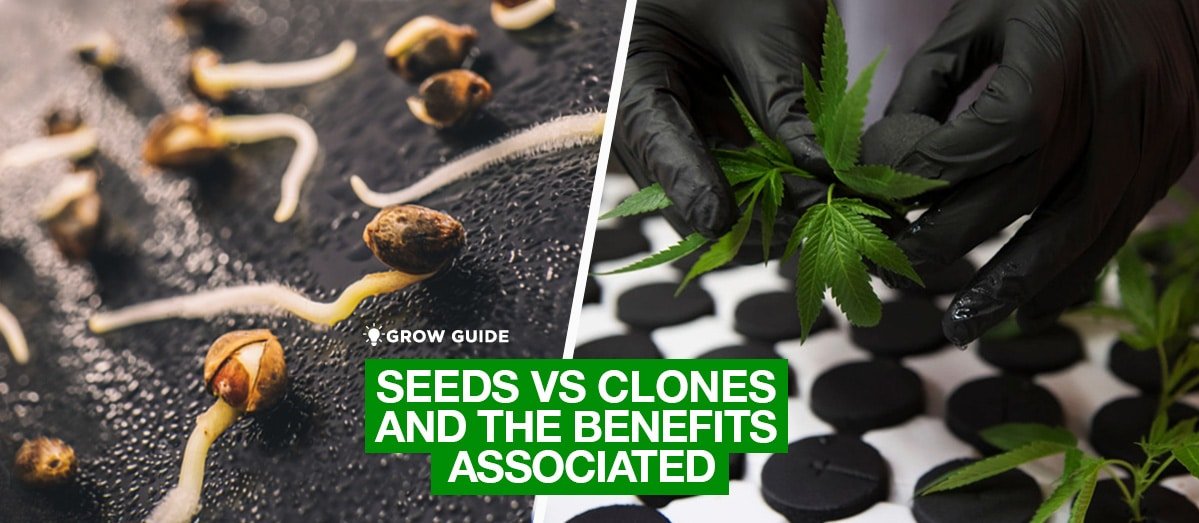If you’re in the cannabis world, you’ve probably heard the age-old debate: seeds or clones? It’s a big question, especially if you’re serious about growing. While seeds have been the traditional route, clones are really making a name for themselves, especially with commercial growers. Why? Because they offer some major perks that align with what today’s market demands: consistency, efficiency, and the ability to keep those top-tier strains going strong. Let’s dive into why clones might just be the better choice.
Seeds vs. Clones: What’s the Deal?
Before we get into why clones are so awesome, let’s break down the basics of seeds and clones in cannabis growing.
Seeds: The OG Way
Seeds are the old-school way of growing cannabis. They come from the union of male and female plants, which means you’re getting a mix of genes. Think of it like siblings—they share some traits, but each one is unique. When you plant seeds, you start from the very beginning: germination, sprouting, seedling growth, and finally, flowering. It’s a process, and while it’s been the go-to for a long time, it has its challenges. There’s the waiting game, the unpredictability, and the chance you’ll end up with male plants that don’t give you those nice buds.
Clones: The Modern Move
Clones are a bit different. They’re cuttings taken from a mature “mother” plant and grown into new plants that are basically carbon copies of the original. This skips the seed stage entirely, giving you a bit of a head start. The real win? Consistency. Clones carry over all the traits of the mother plant, whether it’s flavor, potency, growth habits, or resistance to diseases. This makes them super popular, especially for commercial growers who need every plant to perform predictably.
Why Clones Might Be Your Best Bet
Let’s talk about why clones could be the better option, especially if you’re looking to get serious about your growing game.
1. Genetic Consistency: No Surprises Here
One of the biggest perks of using clones is that you know exactly what you’re getting. With seeds, even if they’re from the same strain, you’re rolling the dice a bit—each plant could turn out a little different. Sometimes that’s cool, but if you’re looking for consistency, it’s a gamble.
Clones take the guesswork out of the equation. Since they’re genetic replicas of the mother plant, you can expect the same results every time. This is huge if you’re growing commercially and need to produce a uniform product. Whether it’s THC levels, flavor, or how the plant grows, clones give you the predictability you need.
To get your hands on those true genetics from California by your favourite breeder, you have to go with clones.
2. Faster Growth: Time Is Money
Growing from seeds takes time—lots of it. First, you’ve got to wait for the seed to germinate, then it has to sprout and grow into a seedling before it even starts looking like a cannabis plant. This process can add weeks to your timeline.
Clones, on the other hand, are already off to the races. They skip the germination and seedling stages, meaning they reach maturity faster. This not only speeds up your grow cycle but also allows you to harvest more often, making better use of your space. For commercial growers, this can mean more product and more profit in less time.
3. No Guesswork: All-Female, All the Time
If you’ve grown from seeds, you know the anxiety of waiting to see if your plants are male or female. Only the females produce the buds you’re after, while males can actually ruin your crop by pollinating the females, leading to seedy buds.
With clones, you don’t have to worry about this at all. They’re taken from female plants, so they’re guaranteed to be female. This means every plant you grow will be productive, maximizing your yield without the stress of sorting out the males.
4. Keeping the Best: Preserve Those Elite Traits
Let’s say you’ve got a plant that’s just perfect—great flavor, strong effects, and super resilient. You want to keep those traits going, right? Cloning lets you do that. By taking cuttings from your star plant, you can replicate it over and over, ensuring you always have a steady supply of that high-quality product. This is especially important if you’re producing a branded product where consistency is key.
5. Efficiency: Less Waste, More Reward
Growing from seeds can be hit or miss. Not all seeds germinate, and even if they do, they might not all survive to adulthood. Plus, if you end up with male plants, you’ve got to pull them, which means you’ve wasted time, space, and resources on something that won’t contribute to your final yield.
Clones, however, are much more reliable. Since they’re already established plants when you start, the chances of them making it to harvest are much higher. Plus, with clones, every plant is female and will produce buds, so you’re not wasting any of your growing space.
The Catch: What to Watch Out for with Clones
Clones are great, but they’re not without their challenges. Here’s what you need to keep in mind.
1. Disease Risks: Clone Carefully
One downside of cloning is that any issues the mother plant has—like pests or diseases—can be passed on to the clones. Since they’re identical copies, they’ll carry over any weaknesses, too.
To avoid this, make sure your mother plant is in top shape before you start cloning. Keep it healthy and free from pests, and maintain a clean environment during the cloning process to reduce the risk of spreading anything nasty. Here at EliteClones we get our mothers tested for HLVd along with any new genetics added to the library
2. Mother Plant Maintenance: A Bit of Extra Work
Keeping a mother plant healthy and productive isn’t a set-it-and-forget-it kind of deal. You need to keep it in a vegetative state, which means making sure it gets the right amount of light, nutrients, and care. This can add some extra work, but the payoff is worth it if you’re looking for consistent, high-quality clones.
3. Limited Genetic Diversity: A Double-Edged Sword
While genetic consistency is a huge advantage of clones, it can also be a drawback. If all your plants are clones from the same mother, you’re essentially creating a monoculture. If a disease or pest targets that specific genetic makeup, it could take out your entire crop.
To avoid putting all your eggs in one basket, some growers use clones from multiple mother plants with different genetics. This introduces some diversity and reduces the risk of losing everything to one problem.
Don’t Count Out Seeds: They Still Have a Role
Even though clones offer a lot of benefits, seeds still play an important role in cannabis cultivation, especially when it comes to breeding and keeping genetic diversity alive.
1. Breeding New Strains: Seeds Are Key
Creating new cannabis strains wouldn’t be possible without seeds. Breeders use seeds to combine different genetic traits and develop new varieties with unique characteristics—like higher potency, better flavors, or improved resistance to pests and diseases.
Once a new strain is stable and consistently produces the desired traits, you can use cloning to propagate it. This way, you get the best of both worlds: innovation from seeds and consistency from clones.
2. Keeping Things Fresh: The Importance of Genetic Diversity
Genetic diversity is crucial for the long-term health of any species, and cannabis is no exception. While clones provide consistency, they also reduce genetic diversity, which can make plants more vulnerable to diseases and pests.
By growing some plants from seeds alongside your clones, you can keep your crop adaptable and resilient, ensuring it can handle whatever comes its way.
3. Finding Balance: Using Both Seeds and Clones
Many savvy growers use a mix of seeds and clones. Seeds are great for introducing new genetics and experimenting with new strains, while clones are perfect for reliably producing those strains once they’re established.
This way, you can keep things fresh and innovative while also maintaining a steady, predictable operation.
Tips for Successful Cloning
If you’re thinking about jumping on the cloning bandwagon, here are a few tips to help you get the best results.
1. Pick a Great Mother Plant: Quality Matters
Your clones are only as good as the mother plant they come from. Make sure to choose a plant that’s healthy, strong, and has all the traits you want in your final product. Keep an eye on your mother plant regularly to ensure it stays in top condition.
2. Cloning Techniques: It’s All in the Details
Cloning is a bit of an art form. Use a sharp, clean blade to take cuttings, and place them in a rooting medium that will support their growth. Keep the environment humid and warm, with gentle light to encourage rooting. With careful handling, your clones will be off to a strong start.
3. Stay Vigilant: Monitor and Adjust
Once your clones are planted, don’t just set them and forget them. Keep a close watch on them, look for any signs of stress or disease, and make adjustments as needed. A little TLC early on will pay off big time when it comes to harvest.
Wrapping It Up
When it comes to cannabis cultivation, the choice between seeds and clones isn’t just a personal preference—it can really impact your success. Clones offer unmatched consistency, faster growth, and the ability to keep those top-shelf traits going strong. But seeds are still important, especially for breeding new strains and keeping your crop genetically diverse.
By understanding the strengths and challenges of both methods, you can make smarter decisions that fit your goals. Whether you’re looking to maximize yield, experiment with new strains, or keep your crop resilient, using a combination of seeds and clones might just be the best way forward.

